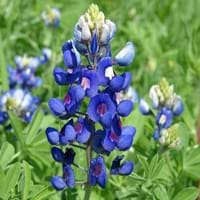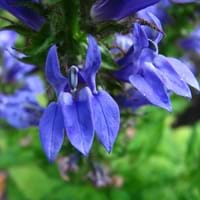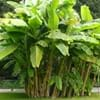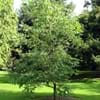Life Span
Perennial
Annual
Type
Flowering Plants
Flowering Plants, Shrubs
Origin
Mediterranean, North Africa, Northern America
America
Types
Anthony Peak Lupine, Silver Bush, Garden Lupine, Spider Lupine, Adonis Lupine
Lobelia aberdarica, Lobelia leschenaultiana, Lobelia canbyi
Habitat
Pine barrens, Sandy areas
Open areas, River side, Woods
USDA Hardiness Zone
3-7
4-9
Sunset Zone
1a, 1b, 2a, 2b, 3a, 3b, 4, 5, 6, 7, 14, 15, 16, 17
A1, A2, A3, H1, H2, 1a, 1b, 2a, 2b, 3a, 3b, 4, 5, 6, 7, 8, 9, 10, 11, 12, 13, 14, 15, 16, 17, 18, 19, 20, 21, 22, 23, 24
Habit
Upright/Erect
Cushion/Mound-forming
Flower Color
Blue, Pink, White
Blue, Red, Violet, White
Flower Color Modifier
Not Available
Bicolor
Fruit Color
Not Available
Not Available
Leaf Color in Spring
Light Green
Dark Green
Leaf Color in Summer
Green
Green
Leaf Color in Fall
Green
Green
Leaf Color in Winter
Not Available
Not Available
Leaf Shape
Oblovate
Cushion
Plant Season
Summer
Fall, Summer
Sunlight
Full Sun, Part sun
Full Sun, Partial shade
Type of Soil
Loose, Moist
Well drained
The pH of Soil
Slightly Acidic
Acidic
Soil Drainage
Well drained
Well drained
Bloom Time
Late Spring, Summer
Early Fall, Early Summer, Late Summer, Mid fall, Mid Spring
Tolerances
Not Available
Not Available
Where to Plant?
Ground
Container, Ground, Pot
How to Plant?
Seedlings
Seedlings
Plant Maintenance
Medium
Medium
Watering Requirements
Form a Soil ring to water efficiently, Keep the ground moist but not water-logged, Requires a lot of watering, Water in morning to avoid prompting diseases
Form a Soil ring to water efficiently, Prefer drip-irrigation instead of Over-head watering, Requires watering in the growing season, Use Mulches to help prevent water loss during hot and windy weather, Water twice a day in the initial period
In Summer
Lots of watering
Lots of watering
In Spring
Moderate
Moderate
In Winter
Average Water
Average Water
Soil pH
Slightly Acidic
Acidic
Soil Type
Loose, Moist
Well drained
Soil Drainage Capacity
Well drained
Well drained
Sun Exposure
Full Sun, Part sun
Full Sun, Partial shade
Pruning
Prune ocassionally
Cut or pinch the stems, Prune after flowering, Prune to control growth, Remove dead or diseased plant parts, Remove deadheads
Fertilizers
All-Purpose Liquid Fertilizer
All-Purpose Liquid Fertilizer
Pests and Diseases
Aphids, Fusarium wilt, Root rot, Thripes
Botrytis Blight, Crown rot, Pythium rot, Stem spot
Plant Tolerance
Drought
Drought
Flower Petal Number
Single
Single
Foliage Texture
Medium
Fine
Foliage Sheen
Matte
Matte
Attracts
Bees
Birds, Hummingbirds
Allergy
Abdominal pain, Asthma, Nausea, Swelling in the face, Vomiting
coma, convulsions, Diarrhea, exhaustion, Nausea, salivation, Vomiting, weakness
Aesthetic Uses
Showy Purposes
Beautification, Bouquets, Showy Purposes, Used for decorating walls, fences, gates, hedges, etc.
Beauty Benefits
Not Available
Not Available
Environmental Uses
Air purification
Air purification
Medicinal Uses
Anthelmintic, Diuretic, Treatment of ulcers
Asthma, Bronchitis, Croup
Part of Plant Used
Flowers, Seeds
Leaves, Seeds
Other Uses
Showy Purposes, Used as Ornamental plant, Used for fragrance
Showy Purposes
Used As Indoor Plant
No
Yes
Used As Outdoor Plant
Yes
Yes
Garden Design
Bedding Plant, Container, Feature Plant, Foundation, Rock Garden
Bedding Plant, Bog Garden, Edging, Foundation, Hanging Basket, Houseplant, Mixed Border, Rock Garden / Wall
Botanical Name
Lupinus
Lobelia laxiflora
Common Name
Hybrid Lupine
Lobelia
In Hindi
वृक संयंत्र
Lobelia
In French
usine de lupin
Lobelia
In Spanish
planta de lupino
Lobelia
In Greek
φυτό λούπινο
λοβηλία
In Portuguese
tremoço planta
Lobélia
In Polish
łubin roślin
Lobelia
In Latin
Plinio herba
Lobelia
Phylum
Magnoliophyta
Anthophyta
Class
Magnoliopsida
Dicotyledonae
Family
Fabaceae
Campanulaceae
Clade
Not Available
Angiosperms, Asterids, Eudicots
Tribe
Not Available
Not Available
Subfamily
Faboideae
Lobelioideae
Season and Care of Lupine and Lobelia
Season and care of Lupine and Lobelia is important to know. While considering everything about Lupine and Lobelia Care, growing season is an essential factor. Lupine season is Summer and Lobelia season is Summer. The type of soil for Lupine is Loose, Moist and for Lobelia is Well drained while the PH of soil for Lupine is Slightly Acidic and for Lobelia is Acidic.
Lupine and Lobelia Physical Information
Lupine and Lobelia physical information is very important for comparison. Lupine height is 2.95 cm and width 1.50 cm whereas Lobelia height is 0.54 cm and width 0.38 cm. The color specification of Lupine and Lobelia are as follows:
Lupine flower color: Blue, Pink and White
Lupine leaf color: Light Green
Lobelia flower color: Blue, Red, Violet and White
- Lobelia leaf color: Dark Green
Care of Lupine and Lobelia
Care of Lupine and Lobelia include pruning, fertilizers, watering etc. Lupine pruning is done Prune ocassionally and Lobelia pruning is done Cut or pinch the stems, Prune after flowering, Prune to control growth, Remove dead or diseased plant parts and Remove deadheads. In summer Lupine needs Lots of watering and in winter, it needs Average Water. Whereas, in summer Lobelia needs Lots of watering and in winter, it needs Average Water.





